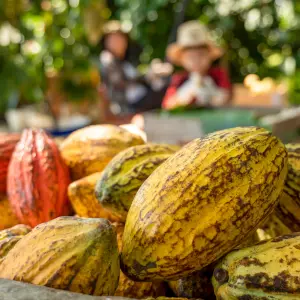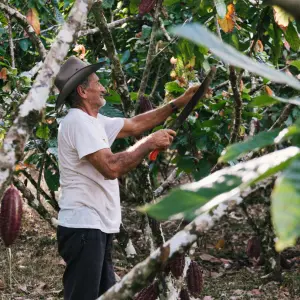Those with a sweet tooth will be delighted to hear it’s World Chocolate Day. Britain is a nation of chocolate lovers, and it won’t be too much of a surprise to learn that the UK is one of the leading chocolate-consuming countries in Europe(1). In fact, the average British shopper enjoys 187 chocolate bars throughout the year(2), with the UK chocolate market worth approximately £5.9 billion(3). Globally, the global trade of chocolate is worth more than a $1tn a year(4). But just how sustainable is a bar of chocolate? We speak to Laura Kirwan PhD to get an understanding of the environmental impacts of the cocoa industry.

The environmental cost of cocoa production
Chocolate is made from a fruit, the cocoa bean, and a cocoa tree will produce two harvests per year of about 50 pods. Cocoa can live for up to 200 years, but only produces viable cocoa beans for 25 years.
Three-quarters of the world’s cocoa is grown in West Africa(5), and a recent study found that cultivation is now a major cause of the destruction of protected forests, with swathes of formerly dense forest becoming cocoa plantations since 2000(6). The research found that 37.4% (360,000 hectares) of the deforestation since 2000 in protected areas in Ivory Coast was linked to cocoa production and it also accounted for 13.5% (193,000 hectares) in similar areas in Ghana.
This understandably has a devastating impact on the local biodiversity. Not only are these habitats often home to threatened species, but deforestation and the use of pesticides affects the quality of the soil and the water supplies in the area. Overtime, over farming causes land degradation, which in turn leads to protected areas being used for new cocoa plantations.

The human cost
Around 50 million people around the world rely on cocoa for their livelihoods(7). But despite the popularity of chocolate, it can be an unstable way of making a living. Much of today’s cocoa production is carried out on small farms of around three to four hectares, and the World Cocoa Foundation estimates that many of the five to six million smallholder farms aren’t paid a living wage and live in extreme poverty(8). Data shows that two-thirds of cocoa farmers live on less than US $2 per day(9).
Unfortunately, cocoa farmers in West Africa only receive 6% of a chocolate bar’s retail price(10), whilst having to deal with high operating costs and the ongoing impacts of climate change, such as droughts and new pests that can destroy crops.
These pressures are why cocoa production is connected with human rights abuses, with small cocoa farmers more likely to use irresponsible labour practices, such as forced and child labour.
A shocking 1.56 million children were in child labour in the cocoa sector in Ghana and Côte d’Ivoire in 2019(11).
What can consumers and foodservice operators do to choose more ethical chocolate?
It doesn’t mean you have to boycott the sweet delights of chocolate though. Organisations such as the WWF-UK are working with the cocoa industry to make it more sustainable, helping farmers to produce high quality cocoa that doesn’t require deforestation or for forests to be converted into farmland.
Fairtrade International also aims to make cocoa farming more sustainable so farmers can better provide for themselves and their families. In 2020, 394 farmer organisations, representing over 440,000 small-scale farmers, held a certificate to produce and sell Fairtrade cocoa.
Consumers should look out for chocolate that uses Rainforest Alliance Certified Cocoa. The certification programme supports farmers to build sustainable livelihood and build climate resilience, as well as tackling the issue of child labour.
There are also many brands out there pledging to improve the sustainability of the supply chain, such as Tony’s Chocolonely who are on a mission to make all chocolate 100% slave-free.
When it comes to looking at the carbon and environmental impact of your ingredients, whether that’s chocolate or anything else, Foodprint from Nutritics is here to support with over 4 million ingredients in its database.
You can contact the team by clicking the button below or visiting https://www.nutritics.com/en/food/carbon-footprint-scoring.
[1] Mintel, UK Chocolate Confectionery Market Report 2022
[2] Mintel’s Global New Products Database, 2018
[3] Mintel, UK Chocolate Confectionery Market Report 2022
[4] Statista, 2022 – see here.
[5] WWF, 2023
[6] School of Biological Sciences, The University of Queensland, 2023
[7] Fairtrade, 2016
[8] World Cocoa Foundation, 2017
[9] International Institute for Sustainable Development, 2022
[10] Rainforest Alliance, 2023
[11] University of Chicago, 2020
